Fort Cumberland Sea Defences (2018)
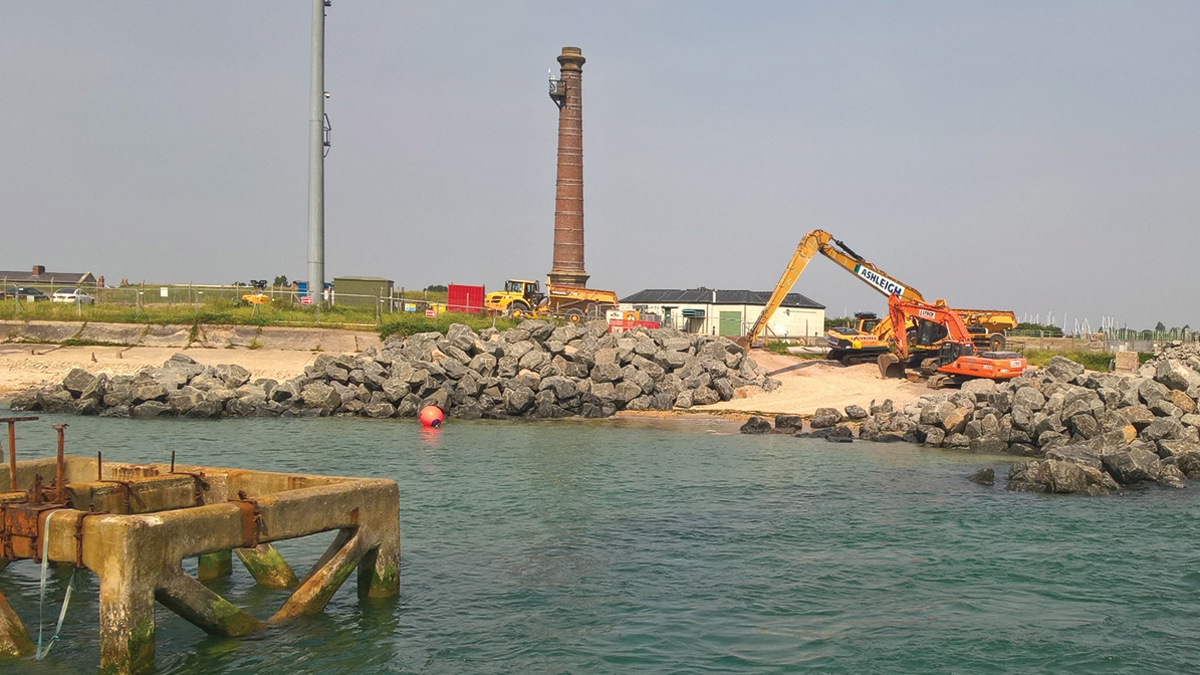
Galliford Try
Three of Southern Water’s underground storm tanks next to the historical Fort Cumberland have played a crucial part in helping to prevent homes in Portsmouth from sewage flooding during stormy weather. Although redundant, the old sea defences protecting the tanks needed replacing and strengthening, and ongoing maintenance is essential to preventing their contents polluting the environment. Southern Water’s £2.8m investment was to import 9,500 tonnes of rock armour to the beach area in front of the tanks, which will protect the Victorian tanks for the next 50 years and at the same time safeguard the Grade II-listed Fort Cumberland.
Background
In 2015 Southern Water invested £10m at Fort Cumberland to improve the resilience and robustness of the storm tanks. This changed the way stormwater (wastewater heavily diluted with rainwater) entered the tanks. Part of the investment was also to refurbish the pumps and screens. These screens capture any debris within the stormwater, such as wet wipes and sanitary waste, before screened storm water is released.
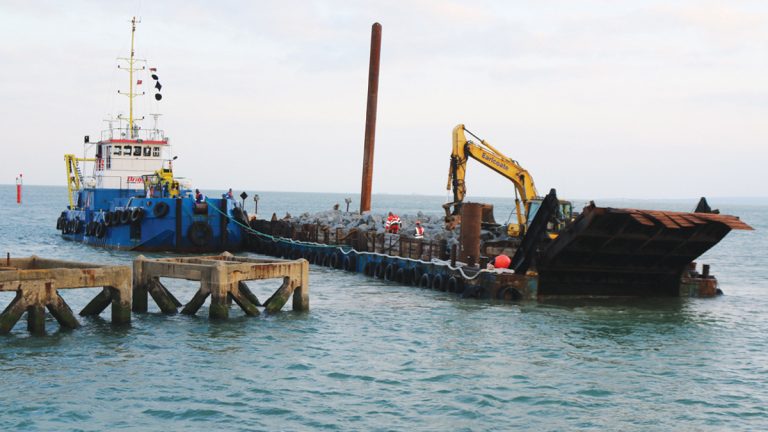
One of the first loads of Norway rock is delivered by barge via Southampton – Courtesy of Southern Water
Undertakings
The provision of coastal defences on this scale is rarely the responsibility of water companies; projects of this sort normally fall under the remit of the Environment Agency and local authorities.
Since Southern Water has not undertaken a scheme of this kind before and there was no precedent it could easily rely on with other water companies, suppliers and construction partners with a proven track record in delivering schemes of this type and magnitude were enlisted. Galliford Try and ABCO Marine, were employed to deliver the project.
Transporting the right rock
9,500 tonnes of rock was transported from Norway to Southampton before being taken by barge and deposited in the sea at high tide. The rock was sourced from Norway because of its type and density. The quarried rock was checked, weighed, graded and safely transported to Southampton’s docks where it was stockpiled and retrieved, when weather conditions were right.
One of the key benefits from importing the Norway rock in this way meant that there were less lorry and traffic movements through the local community.
The rock was quality graded into two sets between 1-3 tonnes and 60-300kgs. These were then placed on a thick geo-textile with the larger rocks at the base and the smaller ones in filling and helping create the levels.
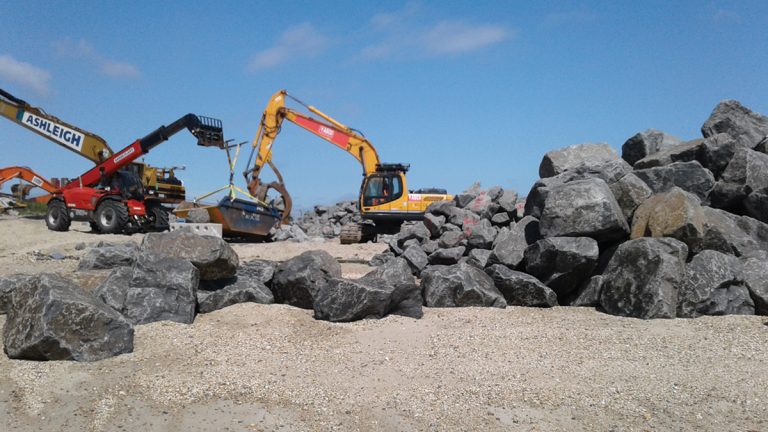
Machinery in full force to shift the rocks from the beach area to form the new sea defences – Courtesy of Southern Water
Excavators were fitted with a GPR system so they did not over-excavate, and this also enabled teams on the ground to check the right amount of rock was being delivered and used.
Out with the old – in with the new
There were many challenges the team had to face throughout the scheme, with constraints including the weather, tide times, bird nesting and migrating seasons, noise, as well as the people using the sea, Langstone Harbour and the beach area.
Construction work took place between April and October, starting with the crushing of the old sea defences. The timeline of work was also designed to work with the tide of the sea, to enable the safe delivery and retrieval of the new rock armour. During low tide and sometimes during late/early hours, a crane was used to collect the rocks from one of several barge deliveries, before dumper trucks brought them to shore. The new rocks were carefully spread across 115m of beach area in direct replacement of the old defences.
A time-lapse camera allowed Southern Water to capture a timeline of the work from start to finish, from a unique position. It was also installed to identify weaknesses in the site security which some groups sought to breach to gain access to the beach.
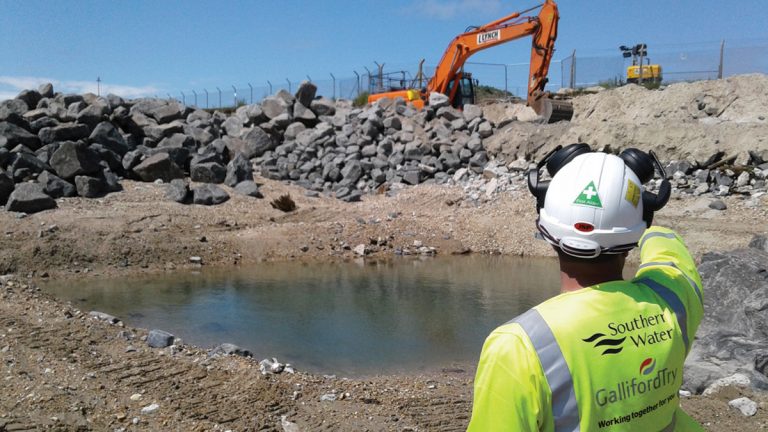
Rock armour is spread over 115m of beach area, adjacent to the historical Fort Cumberland – Courtesy of Southern Water
Working together
Prior to the works commencing, Southern Water’s customer and stakeholder teams engaged with nearby residents, organisations and local authorities, and updates were given throughout the scheme. Due to the tidal restraints, it was necessary to work weekends and out of hours in order to keep to programme.
The project took months of planning and communications with both stakeholders and suppliers, all brought together to support the construction phase of the sea defence at Fort Cumberland, which ultimately ensured that the project could be delivered on time and within budget. With regards to the beach landing of the rock cargo barges, the scheme highlighted collaborative work between Southern Water, Galliford Try, ABCO Marine, Southampton Port and assistance from Langstone Harbour.
After obtaining the necessary permissions to offload rock onto the foreshore at Fort Cumberland, ABCO and Galliford Try opted to offload rock at Southampton’s docks and then carry them on barge from there, which saved time.
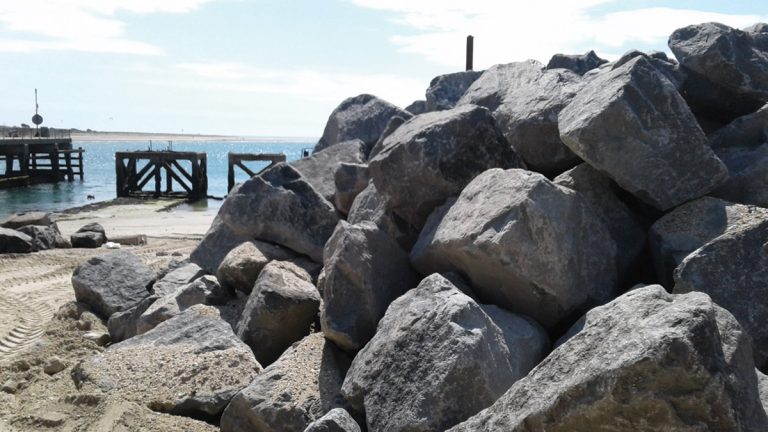
Around 9,500 tonnes of rock was imported from Norway to build the new defences – Courtesy of Southern Water
Benefits
The beach area in front of the storm tanks is popular with dog walkers, anglers and water-sports enthusiasts. With stormy weather on the rise, the risk of breaking the old sea defences and affecting the storm tanks was increasing. This potential damage to the storm tanks could have risked the release of wastewater which would severely impact local marine life and beaches. And it could also damage the historically-important fort.
Successful delivery
The deadline imposed by the Marine Management Organisation of October 31 was met and Fort Cumberland now has a permanent, secure and safe rock revetment that will last long into the future. Built to withstand extreme weather conditions, it will also protect the wider environment. The risk of flooding has been mitigated, as has the potential health and safety risk to the public. Additionally, the new defences creates a more attractive and welcoming environment than before.
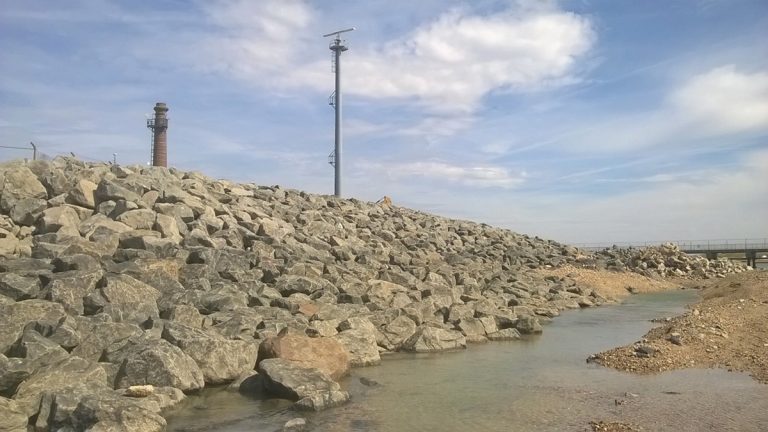
The new defences in position to safeguard Southern Water’s underground storm tanks – Courtesy of Galliford Try
Thanks to detailed and thorough planning and close collaborative working, the scheme was delivered on time, on budget and with an exemplary safety record of zero injuries.
Two months after completion, the team received endorsements from Portsmouth City Council, the Marine Management Organisation and the local harbour master.




